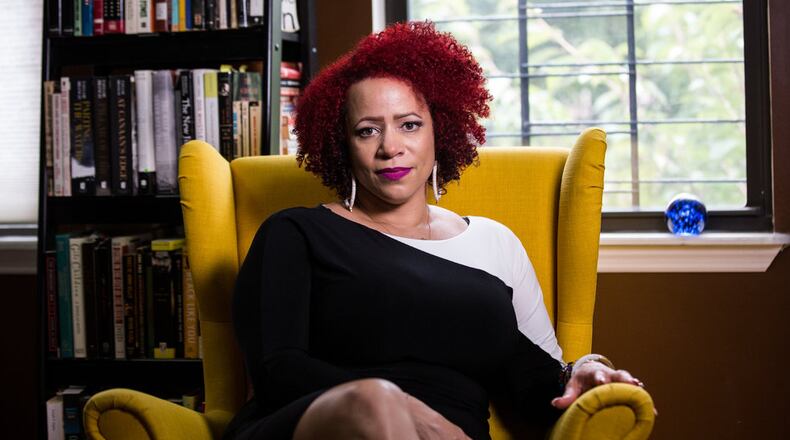In a much-discussed New York Times essay, African American journalist Nikole Hannah-Jones explained the decision she and her husband made to enroll their 4-year-old in a high poverty school rather than use their privilege to get her into a better-performing public school favored by the white parents gentrifying Brooklyn.
Among the alarmed responses from readers:
--Your kid only has one education and you can't experiment with it.
--The idea that dumbing down my children to allow the whole to be better is absurd.
In response to critics who insisted she shouldn’t sacrifice her child to a social justice agenda, Hannah-Jones asked a question that’s become central to her work: “Whose children should be sacrificed?”
America's been all too willing to sacrifice its black and brown children, said Hannah-Jones, who spoke at the Georgia Budget & Policy Institute conference Friday.
She cited the retreat from integrated schools and the rise of a "convenient" narrative characterizing black Americans as less committed to education. That narrative ignores the African Americans who died for the offenses of learning to read or trying to send their children to public schools that they were supporting through their taxes, said Hannah-Jones, a founder of the Ida B. Wells Society for Investigative Reporting and recipient of a MacArthur Genius grant.
Court-ordered integration became personal for Americans at the schoolhouse door, said Hannah-Jones. “If I don’t want to eat at a restaurant with black people, I just don’t go. Schools are where civil rights become intimate.”
It is easy to call out the racism of the 2017 Charlottesville march, she said. What’s harder is decrying the racism in the middle-class white people who rally to stop their children from attending a school like her daughter’s or protest new attendance lines that could bring more poor kids to their neighborhood school.
Such middle-class parents often contend minority families seeking to attend their schools “don’t belong here because they are taking my tax dollars,” said Hannah-Jones. “For the first 200 years of public education in America, black families were funding an education system for white families with nothing in return. Some might say, the debt is owed in that way.”
As a New York Times reporter focusing on racial injustice, Hannah-Jones created the 1619 Project, which re-examines America's legacy of slavery and is being used as a curriculum now in some schools. She is also at work on a book, "The Problem We All Live With," which chronicles the struggles of black Americans for access to equal education.
Her research has convinced her America’s return to segregated schools – easily confirmed with a quick glance around metro Atlanta -- undermines any hope for an equal and just society.
Because, she said, school integration remains the surest route to academic achievement and social mobility. Under a voluntary desegregation program in her town in Iowa, Hannah-Jones traveled an hour across town to attend school in a whiter, richer area starting in second grade. She described the experience as "emotionally and socially fraught, but also as academically stimulating and world-expanding."
In the 2019 book "Children of the Dream: Why School Integration Works," economist Rucker C. Johnson of the University of California, Berkeley, tracked black students who attended integrated schools into adulthood. He found integration significantly increased their educational and career attainments, college quality and earnings, reduced the probability of incarceration, and improved their health outcomes. And those benefits were passed onto their children
“We have one tool that we know works and won’t use it,” Hannah-Jones said. It works far better than charter schools and vouchers, which she contends represent new paths to segregation.
(Hannah-Jones found agreement from Early County Superintendent Bronwyn Ragan-Martin, who, on a panel later with the journalist, said, “Charter schools in South Georgia are basically moving us back to segregation.”)
Those who see integration as a failure often do so because test scores didn’t surge, but Hannah-Jones calls scores a meaningless gauge.
“I am 43-years-old. No one gives a damn what I scored on a test in third grade,” she said.
Looking beyond test scores to life outcomes, black students who attended integrated school come out better on most measures, she said.
Why? According to Johnson’s research, integrated schools provided black students with such advantages as reduced class sizes and increases in per-pupil spending.
As U.S. Supreme Court Justice Thurgood Marshall wrote in his dissent of a 1974 Supreme Court decision, "If the majority is educating its children and making sure every benefit is available, then minority children can also get those benefits if they can attend those schools.”
“Show me a place where it is not true that black kids and white kid in separate schools get different resources…Segregated schools equal segregated life,” said Hannah-Jones.
She shared the story of a teenage girl who was an honor student, athlete and homecoming queen at her segregated Tuscaloosa high school. Like other school districts in the South, Tuscaloosa resegregated once released from court-enforced integration.
“D’Leisha would be considered an all-American girl,” said Hannah-Jones, “except we don’t call little black girls from the poor side of town with an apostrophe in their names all-American girls.”
D’Leisha didn’t earn admission into her dream college, the University of Alabama, never scoring the requisite 23 on the ACT. Her high school preparation did not include the expansive advanced classes available in whiter schools. Nor did the school have a student newspaper or yearbook, said Hannah-Jones.
“For white kids, we clear the hurdles,” said Hannah-Jones. “For low-income kids, we expect them to jump over every hurdle.”
About the Author
The Latest
Featured



